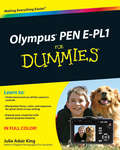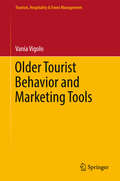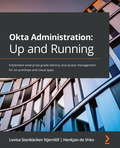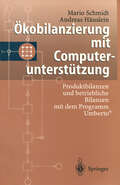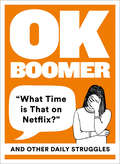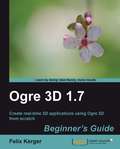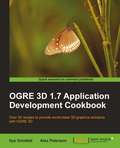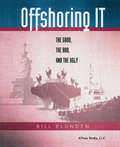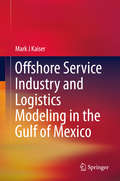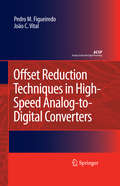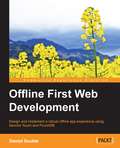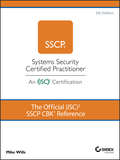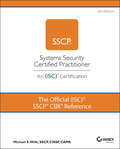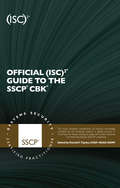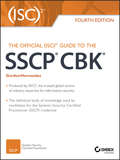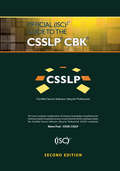- Table View
- List View
Olympus PEN E-PL1 For Dummies
by Julie Adair KingA friendly guide to the Olympus E-PL1, the latest trend in digital cameras Hybrids offer the flexibility of interchangeable lenses and a large sensor in a smaller body. The Olympus E-PL1 lightens your load without sacrificing shooting power and this fun and friendly guide helps you better understand your camera's controls, features, and potential. Veteran author Julie Adair King presents you with examples on how to use your camera's main functions in order to create effective and memorable digital photos. Explains how to work with lenses and shoot in auto mode Covers the on-board controls and situational shooting Addresses manipulating focus and color controls Discusses printing, posting online, and other ways to share images Get started shooting with Olympus E-PL1 For Dummies!
Older Tourist Behavior and Marketing Tools (Tourism, Hospitality & Event Management)
by Vania VigoloThis book provides an in-depth analysis of the older-tourist market, and of the challenges and opportunities created by population ageing from a tourism marketing perspective, by combining a demand-side and a supply-side approach to older tourists. The book is divided into three parts, the first of which defines older tourists and presents a critical review of segmentation approaches. The second part then focuses on the behavior of older tourists in terms of the travel planning process, the use of information and communication technologies for travel purposes, and accommodation choices. The final part analyzes the marketing strategies and operative practices of three tourism companies that focus on the older-adult market. Practical implications for tourism suppliers willing to target older tourists are derived. The book is intended primarily for academics, researchers, and professionals in the tourism and hospitality industry. In addition, it will be useful for students attending advanced tourism and hospitality courses.
Okta Administration Up and Running: Drive operational excellence with IAM solutions for on-premises and cloud apps
by HenkJan Vries Lovisa StjernlöfGet to grips with the fundamentals of Zero trust, IAM, and Okta, while learning how to carry out foundational configuration of your own tenants with the help of step-by-step instructionsKey FeaturesDiscover how to use Okta for complete identity and access management in your organizationExplore agentless desktop single sign-on, multifactor authentication, and lifecycle management for enhanced securityLearn about no-code and low-code automation functionalities, also known as Okta WorkflowsPurchase of the print or Kindle book includes a free PDF eBookBook DescriptionIdentity and access management (IAM) is a set of policies and technologies used to ensure an organization’s security, by carefully assigning roles and access to users and devices. This book will get you up and running with Okta, an IAM service that can help you manage both employees and customers. The book begins by helping you understand how Okta can be used as an IAM platform, before teaching you about Universal Directory and how to integrate with other directories and apps, as well as set up groups and policies for Joiner, Mover, and Leaver flows. This updated edition helps you to explore agentless desktop single sign-on (SSO) and multifactor authentication (MFA) solutions, and showing how to utilize Okta to meet NIST requirements. The chapters also walk you through Okta Workflows, low-/no-code automation functionalities, and custom API possibilities used to improve lifecycle management. Finally, you’ll delve into API access auditing and management, where you’ll discover how to leverage Advanced Server Access (ASA) for your cloud servers. By the end of this book, you’ll have learned how to implement Okta to enhance your organization's security and be able to use the book as a reference guide for the Okta certification exam.What you will learnGet a clear overview of Okta’s advanced featuresIntegrate Okta with directories and applications using hands-on instructionsGet practical recommendations on managing policies for SSO, MFA, and lifecycle managementDiscover how to manage groups and group rules for Joiner, Mover, Leaver events in Okta using examplesManage your Okta tenants using APIs and oversee API access with OktaSet up and manage your organization’s Okta environment, ensuring a secure IAM practiceFind out how to extend your Okta experience with Workflows and ASAWho this book is forIf you are an IT consultant, business decision-maker, system administrator, system and security engineer, or anyone looking to use Okta to plan, design, and implement identity and access management solutions, this book is for you. A basic understanding of authentication and authorization is necessary to understand the topics present in this book.
Okta Administration Up and Running: Drive operational excellence with IAM solutions for on-premises and cloud apps
by HenkJan Vries Lovisa StjernlöfGet to grips with the fundamentals of Zero trust, IAM, and Okta, while learning how to carry out foundational configuration of your own tenants with the help of step-by-step instructionsKey FeaturesDiscover how to use Okta for complete identity and access management in your organizationExplore agentless desktop single sign-on, multifactor authentication, and lifecycle management for enhanced securityLearn about no-code and low-code automation functionalities, also known as Okta WorkflowsPurchase of the print or Kindle book includes a free PDF eBookBook DescriptionIdentity and access management (IAM) is a set of policies and technologies used to ensure an organization’s security, by carefully assigning roles and access to users and devices. This book will get you up and running with Okta, an IAM service that can help you manage both employees and customers. The book begins by helping you understand how Okta can be used as an IAM platform, before teaching you about Universal Directory and how to integrate with other directories and apps, as well as set up groups and policies for Joiner, Mover, and Leaver flows. This updated edition helps you to explore agentless desktop single sign-on (SSO) and multifactor authentication (MFA) solutions, and showing how to utilize Okta to meet NIST requirements. The chapters also walk you through Okta Workflows, low-/no-code automation functionalities, and custom API possibilities used to improve lifecycle management. Finally, you’ll delve into API access auditing and management, where you’ll discover how to leverage Advanced Server Access (ASA) for your cloud servers. By the end of this book, you’ll have learned how to implement Okta to enhance your organization's security and be able to use the book as a reference guide for the Okta certification exam.What you will learnGet a clear overview of Okta’s advanced featuresIntegrate Okta with directories and applications using hands-on instructionsGet practical recommendations on managing policies for SSO, MFA, and lifecycle managementDiscover how to manage groups and group rules for Joiner, Mover, Leaver events in Okta using examplesManage your Okta tenants using APIs and oversee API access with OktaSet up and manage your organization’s Okta environment, ensuring a secure IAM practiceFind out how to extend your Okta experience with Workflows and ASAWho this book is forIf you are an IT consultant, business decision-maker, system administrator, system and security engineer, or anyone looking to use Okta to plan, design, and implement identity and access management solutions, this book is for you. A basic understanding of authentication and authorization is necessary to understand the topics present in this book.
Okta Administration: Implement enterprise-grade identity and access management for on-premises and cloud apps
by Lovisa Stenbacken Stjernlof HenkJan de VriesPlan, design, and implement identity and access management solutions with OktaKey FeaturesLearn how to use Okta for complete identity and access management in your organizationUse single sign-on, multifactor authentication, and life cycle management for enhanced securitySet up, manage, and audit API access policiesBook DescriptionIAM, short for identity and access management, is a set of policies and technologies for ensuring the security of an organization through careful role and access assignment for users and devices. With this book, you'll get up and running with Okta, an identity and access management (IAM) service that you can use for both employees and customers. Once you've understood how Okta can be used as an IAM platform, you'll learn about the Universal Directory, which covers how to integrate other directories and applications and set up groups and policies. As you make progress, the book explores Okta's single sign-on (SSO) feature and multifactor authentication (MFA) solutions. Finally, you will delve into API access management and discover how you can leverage Advanced Server Access for your cloud servers and Okta Access Gateway for your on-premises applications. By the end of this Okta book, you'll have learned how to implement Okta to enhance your organization's security and be able to use this book as a reference guide for the Okta certification exam.What you will learnUnderstand different types of users in Okta and how to place them in groupsSet up SSO and MFA rules to secure your IT environmentGet to grips with the basics of end-user functionality and customizationFind out how provisioning and synchronization with applications workExplore API management, Access Gateway, and Advanced Server AccessBecome well-versed in the terminology used by IAM professionalsWho this book is forIf you are an IT consultant, business decision-maker, system administrator, system and security engineer, or anyone who wishes to use Okta to plan, design, and implement identity and access management solutions, this book is for you. A basic understanding of authentication and authorization is necessary.
Ökonometrie und maschinelles Lernen: Basiswissen für Ökonomen (essentials)
by Silvio AndraeFür empirische Wirtschaftswissenschaftler gehören ökonometrische Methoden zum Standardwerkzeug. Die neuen Instrumente des maschinellen Lernens setzen sich langsam auch in der Volks- und Betriebswirtschaftslehre durch. Das Buch vermittelt Basiswissen zu den spezifischen Methoden des überwachten und unüberwachten Lernens sowie des Verstärkungslernens. Dabei werden die wesentlichen Unterschiede in Bezug auf Ziele, Methoden und Rahmenbedingungen zwischen den Methoden der Ökonometrie und des maschinellen Lernens dargestellt und erörtert.
Ökologische Datensätze — Programme für AOS-Rechner und BASIC-Taschencomputer (Anwendung programmierbarer Taschenrechner #24)
by Michael MeyerIn einer Zeit, in der man den umweltschädigenden Einfluß unserer technologischen Gesell schaften immer deutlicher zu spüren bekommt, muß zwangsläufig die "Lehre vom Haus halt der Natur", also die Ökologie, an Bedeutung zunehmen. Daß diese Wissenschaft sich nicht nur um die Rettung der vom Aussterben bedrohten Tiere und Pflanzen bemüht, sondern auch die in ihrer Existenzgrundlage sich selbst gefährdende Menschheit in ihre Betrachtung einbezieht, ist eine Tatsache, die bisher leider nicht in weiten Kreisen der Be völkerung bewußt gemacht wurde. Man kann wohl getrost behaupten, ökologische For schung sei neben einer ausgewogenen Politik und neben akzeptablen Konzepten der Öko nomie für den Fortbestand der Menschheit notwendig. Der Ökologe stützt sich bei seinen Untersuchungen auf nur verbal beschreibbare Beob achtungen (welche allerdings oft durch Fotos oder Zeichnungen dokumentarisch festge halten werden können) und auf (mehr oder weniger) objektive Meßdaten. Liegen nach der Untersuchung letztere vor, müssen diese in irgendeiner Weise in logischen Zusammen hang gebracht werden, sie müssen also verarbeitet werden. Bei der Auswahl von nume rischen Verfahren muß der Ökologe allerdings größtenteils auf fachfremde Literatur zu rückgreifen, d. h. Werke der mathematischen, naturwissenschaftlichen, sozialwissenschaft lichen und medizinischen Statistik sowie der praktischen Mathematik für technisch-natur wissenschaftliche Disziplinen. Entsprechend muß er sich Taschenrechnerprogramme für die Datenauswertung aus Büchern anderer Fachdisziplinen zusammensuchen. Für eine Wissenschaft, die - wie oben angedeutet - so bedeutungsvoll wurde, ist es allmählich an der Zeit, daß sie ihre eigene Literatur zu diesem Thema erhält.
Ökobilanzierung mit Computerunterstützung: Produktbilanzen und betriebliche Bilanzen mit dem Programm Umberto®
by Mario SchmidtOK Boomer: 'what Time Is That On Netflix?' And Other Daily Struggles
by HarperCollinsA hilarious collection of the very best ‘OK Boomer’ moments of the internet covering all aspects of modern life – the climate crisis to technology, customer service to pop culture, money to working life.
Ogre 3D 1.7 Beginner's Guide: Create Real Time 3d Applications Using Ogre 3d From Scratch
by Felix KergerThis book is an example-driven introduction to OGRE 3D. Each example shows some new features and you learn step-by-step to create complex scenes with different effects using OGRE 3D. After several examples discussing one topic there is a do-it-yourself part where you will be challenged to solve problems on your own. If you have ever wanted to develop 3D applications with OGRE 3D, this example-driven book will enable you to do so. Understanding of C++ is needed to follow the examples in the book.
OGRE 3D 1.7 Application Development Cookbook
by Ilya Grinblat Alex PetersonThis is a cookbook with over 50 recipes offering solutions to common application development problems while creating graphics using OGRE 3D, with explained sample code and screenshots added in. Each recipe teaches you about a particular feature of OGRE 3D. If you are a C++ programmer with basic knowledge of OGRE 3D and want to enhance your knowledge about OGRE 3D further, then this book is for you. Basic knowledge of 3D graphics application development is required.
Offshoring IT: The Good, the Bad, and the Ugly
by Bill Blunden* Offers a Well-Rounded Discussion Based on Opposing Views. * Discusses the Obstacles that Confront Offshore Employers, such as the foreign nation's: * Infrastructure (availability of electricity, transportation, water, food, etc). * Political stability. * Distance from the U.S. * Mortality rate. * Health care. * Presents an Exhaustive Survey of Companies Going Offshore. * Offers a Realistic Look at Potential Endgame Scenarios.
Offshore Service Industry and Logistics Modeling in the Gulf of Mexico
by Mark J KaiserThe purpose of this book is to examine the geospatial and temporal linkage between offshore supply vessels and oil and gas activity in the Outer Continental Shelf Gulf of Mexico, and to model OSV activity expected to result from future lease sales. Oil and gas operations occur throughout the world wherever commercial accumulations exist, but no quantitative assessment has ever been performed on the marine vessels that support offshore activity. The OCS Gulf of Mexico is the largest and most prolific offshore oil and gas basin in the world, and a large number of marine vessels are engaged in operations in the region, but tracking their activity is difficult and requires specialized data sources and the development of empirical models. The challenge of modeling arises from the complexity and size of the system, and the particular limitations governing stochastic difficult-to-observe networks. This book bridges the gap with the latest technological perspective and provides insight and computational methods to inform and better understand the offshore sector.Offshore Service Industry and Logistics Modeling in the Gulf of Mexico is presented in three parts. In Part 1, background information on the life cycle stages of offshore development and activity is reviewed, along with a description of the service vessels and port infrastructure in the region. In Part 2, OSV activity in the Gulf of Mexico is baselined using PortVision data to establish spatial and temporal characteristics of vessel activity. In Part 3, the analytic framework used to quantify the connection between OSVs, ports, and offshore activity is described, and activity expected to arise from the 2012-2017 OCS lease program is forecast.Providing an invaluable resource for academics and researchers, this book is also intended for government regulators, energy and environmental analysts, industry professionals, and others interested in this often-overlooked sector.
Offset Reduction Techniques in High-Speed Analog-to-Digital Converters: Analysis, Design and Tradeoffs (Analog Circuits and Signal Processing)
by Pedro M. Figueiredo João C. VitalOffset Reduction Techniques in High-Speed Analog-to-Digital Converters analyzes, describes the design, and presents test results of Analog-to-Digital Converters (ADCs) employing the three main high-speed architectures: flash, two-step flash and folding and interpolation. The advantages and limitations of each one are reviewed, and the techniques employed to improve their performance are discussed.
Offline First Web Development
by Daniel SaubleDesign and implement a robust offline app experience using Sencha Touch and PouchDB About This Book • Understand the design principles behind a well-designed offline experience • Create the illusion of being online when you're really offline • Use common libraries such as Sencha Touch and PouchDB to enhance the offline experience of mobile apps Who This Book Is For Do you want to make your app experience more robust and delightful? Are you eager to write apps that cater to a wider audience, not just the Silicon Valley crowd? Do you need to persuade your peers that offline-first is a worthwhile development paradigm? If your answer to all or any one of these questions is yes, then this is the book is for you. Some previous coding and command-line experience would be useful, but is not required. What You Will Learn • Design the behavior of the app, taking offline, online, and the transition between those two states into account • Seamlessly implement the offline/online experience that you've designed using Sencha Touch and PouchDB • Show the user what's happening under the hood with online/offline indicators and Good Mobile Messaging • Employ various strategies to cope with unreliable network conditions • Help the user resolve conflicts related to the “split-brain” problem • Choose intelligent defaults based on usage of the app • Use point-to-point networking to partially overcome a lack of Internet connectivity In Detail When building mobile apps, it's easy to forget about the moments when your users lack a good Internet connection. Put your phone in airplane mode, open a few popular apps, and you'll quickly see how they handle being offline. From Twitter to Pinterest to Apple Maps, some apps might handle being offline better—but very few do it well. A poor offline experience will result in frustrated users who will abandon your app, or worse, turn to your competitor's apps! Expert or novice, this book will teach you everything you need to know about designing and building a rigorous offline app experience. By putting the offline experience first, you'll have a solid foundation to build upon, avoiding the unnecessary stress and frustration of trying to retrofit offline capabilities into your finished app. This basic principle, designing for the worst-case scenario, could save you countless hours of wasted effort. Style and approach This book adopts an iterative approach to designing and building a mobile app, where each chapter builds on the one before, resulting in a fully-functional app that demonstrates the concepts taught, each one of which is explained through the use of an example.
Offline!: Der Kollaps der globalen digitalen Zivilisation
by Thomas GrüterIn der Geschichte der Menschheit entstanden und vergingen mehr als 50 Hochkulturen und Zivilisationen. Auffällig dabei: Die meisten zerfielen in nur wenigen Jahrzehnten – unmittelbar nach dem Gipfelpunkt ihrer Macht und ihres Reichtums. Kann uns das auch passieren?Heute, zu Beginn des 21. Jahrhunderts, dominiert nur eine einzige Lebensweise: die globale digitale Zivilisation. Ohne Smartphones, Computer, GPS und Suchmaschinen geht nichts mehr. Nirgendwo. Und noch immer ist der Fortschritt rasant. Hat unsere Zivilisation vielleicht schon bald ihren Höhepunkt erreicht? Das Buch trägt beunruhigende Indizien dafür zusammen – und trifft damit den Nerv der Zeit. In Europa glaubt schon heute eine Mehrheit der Menschen, dass es ihren Kindern schlechter gehen wird als ihnen.Thomas Grüter vertritt die These, dass nicht Pandemien, Supervulkane oder Sonnenstürme die größten Risiken der Menschheit sind. Vielmehr droht das komplexe Grundgerüst unsere Zivilisation seine Stabilität zu verlieren. Selbst ohne die Belastung durch Klimawandel und Bodendegradation könnte es von innen her zerfallen. In zehn Kapiteln untersucht das Buch die Risiken der modernen Informationsgesellschaft, z.B:· Wie anfällig sind die Infrastrukturen und speziell die digitale Infrastruktur?· Wie stabil ist das gespeicherte Wissen? Können medizinische und naturwissenschaftliche Erkenntnisse überhaupt wieder verloren gehen?· Muss eine Wirtschaft, die auf ständiges Wachstum und globalen Handel angewiesen ist, irgendwann kollabieren? · Wann gehen uns die Rohstoffe aus, und ist das überhaupt absehbar? · Wie sicher sind Zukunftsvorsagen?· Welche Gefahr geht von Cyberkriegen aus? · Wie könnte die Gesellschaft nach dem Ende des Internets und der Smartphones aussehen?· Was lernen wir aus dem Zerfall früherer Zivilisationen?· Mit welchen Maßnahmen können wir einen plötzlichen Zerfall der digitalen Lebensweise abfedern oder vermeiden? Spannend geschrieben und umfassend recherchiert, gibt das Buch schlüssige Antworten auf die entscheidende Frage: Wie vermeiden wir die Fehler, an denen bisher alle Zivilisationen gescheitert sind? Das Buch legt die Sollbruchstellen der globalen digitalen Zivilisation offen und weist Wege aus der Krise. Wenn die Menschheit alle anstehenden Probleme meistert, dann steht ihr irgendwann der Weg zu den Sternen offen.
Offline!: Das unvermeidliche Ende des Internets und der Untergang der Informationsgesellschaft
by Thomas GrüterNoch in diesem Jahrhundert wird die Informationsgesellschaft an ihr Ende kommen, weil die globalen Informationsnetze reißen. Das ist die provozierende These des Wissenschaftlers und Sachbuchautors Thomas Grüter. Den meisten Menschen erscheint das Internet wie eine eigene Welt, in der Entfernungen keine Rolle spielen, Daten wie von selbst um den Globus fliegen und alles Wissen dauerhaft auf Knopfdruck zur Verfügung steht. Aber dieser Eindruck, so Grüter, täuscht: Das Internet ist eine von Menschen geschaffene Scheinwelt, die mit immens hohem Aufwand in Betrieb gehalten wird. Dennoch vertrauen wir dieser störanfälligen Schöpfung einige unsere wichtigsten Schätze an: nämlich unser Wissen und die Steuerung der Infrastrukturen, die uns am Leben erhalten. Der Autor zeigt in seinem nachdenklich stimmenden Buch zweierlei: warum das gefährlich ist und wie wir Vorsorge treffen können, bevor es zu spät ist. In der Entwicklung der Menschheit könnte die Informationsgesellschaft durchaus einen wichtigen Meilenstein darstellen. Doch wenn wir vergessen, ihre grundlegenden Strukturen zu sichern, wird sie zusammenbrechen, bevor sie wirklich Fuß gefasst hat. Grüter argumentiert schlüssig und weist nach, wie zerbrechlich die Grundlagen unserer Lebenswelt sind. Ein wichtiges und aufrüttelndes Buch zur rechten Zeit!
The Official (ISC)2 SSCP CBK Reference
by Mike WillsThe only official body of knowledge for SSCP—(ISC)2’s popular credential for hands-on security professionals—fully revised and updated. Systems Security Certified Practitioner (SSCP) is an elite, hands-on cybersecurity certification that validates the technical skills to implement, monitor, and administer IT infrastructure using information security policies and procedures. SSCP certification—fully compliant with U.S. Department of Defense Directive 8140 and 8570 requirements—is valued throughout the IT security industry. The Official (ISC)2 SSCP CBK Reference is the only official Common Body of Knowledge (CBK) available for SSCP-level practitioners, exclusively from (ISC)2, the global leader in cybersecurity certification and training. This authoritative volume contains essential knowledge practitioners require on a regular basis. Accurate, up-to-date chapters provide in-depth coverage of the seven SSCP domains: Access Controls; Security Operations and Administration; Risk Identification, Monitoring and Analysis; Incident Response and Recovery; Cryptography; Network and Communications Security; and Systems and Application Security. Designed to serve as a reference for information security professionals throughout their careers, this indispensable (ISC)2guide: Provides comprehensive coverage of the latest domains and objectives of the SSCP Helps better secure critical assets in their organizations Serves as a complement to the SSCP Study Guide for certification candidates The Official (ISC)2 SSCP CBK Reference is an essential resource for SSCP-level professionals, SSCP candidates and other practitioners involved in cybersecurity.
The Official (ISC)2 SSCP CBK Reference
by Mike WillsThe only official body of knowledge for SSCP—(ISC)2’s popular credential for hands-on security professionals—fully revised and updated. Systems Security Certified Practitioner (SSCP) is an elite, hands-on cybersecurity certification that validates the technical skills to implement, monitor, and administer IT infrastructure using information security policies and procedures. SSCP certification—fully compliant with U.S. Department of Defense Directive 8140 and 8570 requirements—is valued throughout the IT security industry. The Official (ISC)2 SSCP CBK Reference is the only official Common Body of Knowledge (CBK) available for SSCP-level practitioners, exclusively from (ISC)2, the global leader in cybersecurity certification and training. This authoritative volume contains essential knowledge practitioners require on a regular basis. Accurate, up-to-date chapters provide in-depth coverage of the seven SSCP domains: Access Controls; Security Operations and Administration; Risk Identification, Monitoring and Analysis; Incident Response and Recovery; Cryptography; Network and Communications Security; and Systems and Application Security. Designed to serve as a reference for information security professionals throughout their careers, this indispensable (ISC)2guide: Provides comprehensive coverage of the latest domains and objectives of the SSCP Helps better secure critical assets in their organizations Serves as a complement to the SSCP Study Guide for certification candidates The Official (ISC)2 SSCP CBK Reference is an essential resource for SSCP-level professionals, SSCP candidates and other practitioners involved in cybersecurity.
The Official (ISC)2 SSCP CBK Reference
by Mike WillsThe only official body of knowledge for SSCP—(ISC)2’s popular credential for hands-on security professionals—fully revised and updated 2021 SSCP Exam Outline. Systems Security Certified Practitioner (SSCP) is an elite, hands-on cybersecurity certification that validates the technical skills to implement, monitor, and administer IT infrastructure using information security policies and procedures. SSCP certification—fully compliant with U.S. Department of Defense Directive 8140 and 8570 requirements—is valued throughout the IT security industry. The Official (ISC)2 SSCP CBK Reference is the only official Common Body of Knowledge (CBK) available for SSCP-level practitioners, exclusively from (ISC)2, the global leader in cybersecurity certification and training. This authoritative volume contains essential knowledge practitioners require on a regular basis. Accurate, up-to-date chapters provide in-depth coverage of the seven SSCP domains: Security Operations and Administration; Access Controls; Risk Identification, Monitoring and Analysis; Incident Response and Recovery; Cryptography; Network and Communications Security; and Systems and Application Security. Designed to serve as a reference for information security professionals throughout their careers, this indispensable (ISC)2 guide: Provides comprehensive coverage of the latest domains and objectives of the SSCP Helps better secure critical assets in their organizations Serves as a complement to the SSCP Study Guide for certification candidates The Official (ISC)2 SSCP CBK Reference is an essential resource for SSCP-level professionals, SSCP candidates and other practitioners involved in cybersecurity.
The Official (ISC)2 SSCP CBK Reference
by Mike WillsThe only official body of knowledge for SSCP—(ISC)2’s popular credential for hands-on security professionals—fully revised and updated 2021 SSCP Exam Outline. Systems Security Certified Practitioner (SSCP) is an elite, hands-on cybersecurity certification that validates the technical skills to implement, monitor, and administer IT infrastructure using information security policies and procedures. SSCP certification—fully compliant with U.S. Department of Defense Directive 8140 and 8570 requirements—is valued throughout the IT security industry. The Official (ISC)2 SSCP CBK Reference is the only official Common Body of Knowledge (CBK) available for SSCP-level practitioners, exclusively from (ISC)2, the global leader in cybersecurity certification and training. This authoritative volume contains essential knowledge practitioners require on a regular basis. Accurate, up-to-date chapters provide in-depth coverage of the seven SSCP domains: Security Operations and Administration; Access Controls; Risk Identification, Monitoring and Analysis; Incident Response and Recovery; Cryptography; Network and Communications Security; and Systems and Application Security. Designed to serve as a reference for information security professionals throughout their careers, this indispensable (ISC)2 guide: Provides comprehensive coverage of the latest domains and objectives of the SSCP Helps better secure critical assets in their organizations Serves as a complement to the SSCP Study Guide for certification candidates The Official (ISC)2 SSCP CBK Reference is an essential resource for SSCP-level professionals, SSCP candidates and other practitioners involved in cybersecurity.
Official (ISC)2 Guide to the SSCP CBK
by R Anderson J D DewarThe (ISC) Systems Security Certified Practitioner (SSCP ) certification is one of the most important credentials an information security practitioner can have. Having helped thousands of people around the world obtain this distinguished certification, the bestselling Official (ISC)2 Guide to the SSCP CBK has quickly become the book that many of
The Official (ISC)2 Guide to the SSCP CBK
by Adam Gordon Steven HernandezThe fourth edition of the Official (ISC)2® Guide to the SSCP CBK® is a comprehensive resource providing an in-depth look at the seven domains of the SSCP Common Body of Knowledge (CBK). This latest edition provides an updated, detailed guide that is considered one of the best tools for candidates striving to become an SSCP. The book offers step-by-step guidance through each of SSCP’s domains, including best practices and techniques used by the world's most experienced practitioners. Endorsed by (ISC)² and compiled and reviewed by SSCPs and subject matter experts, this book brings together a global, thorough perspective to not only prepare for the SSCP exam, but it also provides a reference that will serve you well into your career.
The Official (ISC)2 Guide to the SSCP CBK
by Adam Gordon Steven HernandezThe fourth edition of the Official (ISC)2® Guide to the SSCP CBK® is a comprehensive resource providing an in-depth look at the seven domains of the SSCP Common Body of Knowledge (CBK). This latest edition provides an updated, detailed guide that is considered one of the best tools for candidates striving to become an SSCP. The book offers step-by-step guidance through each of SSCP’s domains, including best practices and techniques used by the world's most experienced practitioners. Endorsed by (ISC)² and compiled and reviewed by SSCPs and subject matter experts, this book brings together a global, thorough perspective to not only prepare for the SSCP exam, but it also provides a reference that will serve you well into your career.
Official (ISC)2 Guide to the CSSLP CBK
by Mano PaulApplication vulnerabilities continue to top the list of cyber security concerns. While attackers and researchers continue to expose new application vulnerabilities, the most common application flaws are previous, rediscovered threats. The text allows readers to learn about software security from a renowned security practitioner who is the appointed software assurance advisor for (ISC)2. Complete with numerous illustrations, it makes complex security concepts easy to understand and implement. In addition to being a valuable resource for those studying for the CSSLP examination, this book is also an indispensable software security reference for those already part of the certified elite. A robust and comprehensive appendix makes this book a time-saving resource for anyone involved in secure software development.
